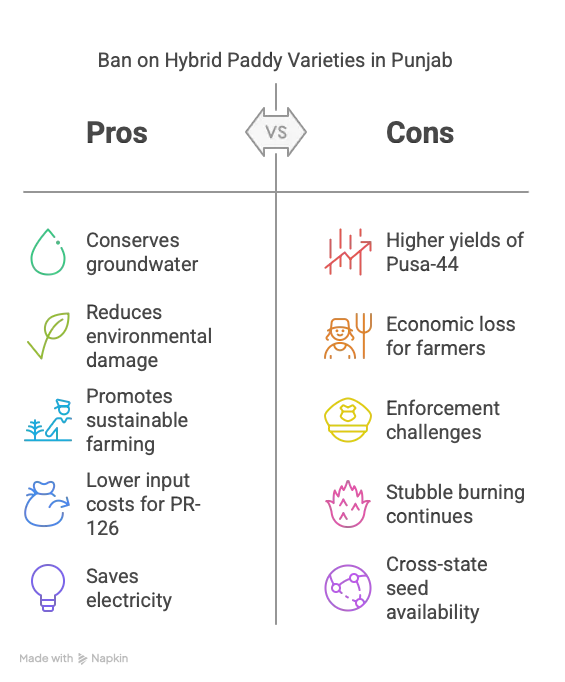UPSC
Exam Nugget
Punjab’s Hybrid Paddy Seed Ban: Balancing Agriculture and Environment
Last Updated
11th April, 2025
Date Published
11th April, 2025
Share This Post With Someone


- Ban Announcement: On April 7, 2025, Punjab government banned the sale and cultivation of hybrid paddy varieties, including Pusa-44, for the 2025 kharif season.
- Objective: Aims to conserve groundwater, reduce environmental damage, and promote sustainable farming practices.
- Pusa-44 Background: A long-duration, high-yield variety (35–36 quintals/acre) developed by the Indian Agricultural Research Institute (IARI) in 1993, requiring 155–160 days to mature.
- Environmental Concerns:
- Pusa-44’s high water consumption (5–6 extra irrigation cycles) exacerbates Punjab’s groundwater depletion, with 78% of blocks in the dark zone.
- Produces 2–3% more stubble than short-duration varieties, contributing to stubble burning and air pollution.
- Susceptible to blight and sap-sucking insects, increasing pesticide use and costs.
- Punjab Agricultural University (PAU) Recommendations: Advocates short-duration varieties like PR-126 (125 days, 30 quintals/acre) and direct seeding to save water and reduce stubble burning.
- Economic Impact:
- Pusa-44’s high yield fetches ₹9,280–11,600 more per acre at ₹2,320/quintal MSP, but higher input costs (irrigation, pesticides) reduce net gains.
- PR-126 offers lower input costs (29.6% less than Pusa-44), improving farmer economics despite lower yields.
- Implementation Challenges:
- Farmers prefer Pusa-44 for higher yields, saving seeds from previous harvests, bypassing the ban.
- Hybrid seeds reportedly sold from Haryana, where no ban exists, complicating enforcement.
- Early transplantation (June 1 instead of June 10) may encourage long-duration varieties like Pusa-44.
- Rice Millers’ Concerns:
- Hybrid varieties, including those mislabeled as PR-126, yield lower milling out-turn ratios (60–62% vs. 67% for PR-126), causing financial losses.
- Millers demand DNA testing to distinguish hybrids from certified varieties.
- Expert Critique:
- Ajai Rana, Federation of Seed Industry of India, argues hybrids increase productivity (8.5–9.5 MT/ha vs. 4.3 MT/ha nationally) and save 20–25% water, citing U.S. and China’s hybrid use (60–65% of rice area).
- Critics highlight Punjab’s high baseline yields with non-hybrids, questioning the ban’s scientific basis.
- Farmer Perspectives:
- Farmers like Gurbakhshish from Patiala doubt the ban’s effectiveness due to cross-state seed availability.
- Higher yields of hybrids remain attractive despite environmental costs.
- State Context:
- Punjab’s 32 lakh hectares under paddy in 2024–25, a record high, strains water resources.
- Government claims reducing Pusa-44 area in 2023 saved 5 billion cusecs of water and ₹477 crore in electricity.
- Policy Contradictions: Advancing transplantation dates may counteract water-saving goals by favoring long-duration varieties.
Glossary:
- Hybrid Paddy: Rice varieties bred for higher yields but requiring annual seed purchase and more inputs.
- Pusa-44: A long-duration, high-yield paddy variety banned in Punjab for its water and stubble issues.
- PR-126: A short-duration paddy variety recommended for water efficiency and lower stubble production.
- Stubble Burning: The practice of burning crop residue to clear fields, contributing to air pollution.
- Minimum Support Price (MSP): A government-set price guaranteeing farmers a minimum income for crops.
Link To The Original Article – https://indianexpress.com/article/explained/punjab-bans-sale-of-hybrid-paddy-seeds-everything-you-need-to-know-9939131/